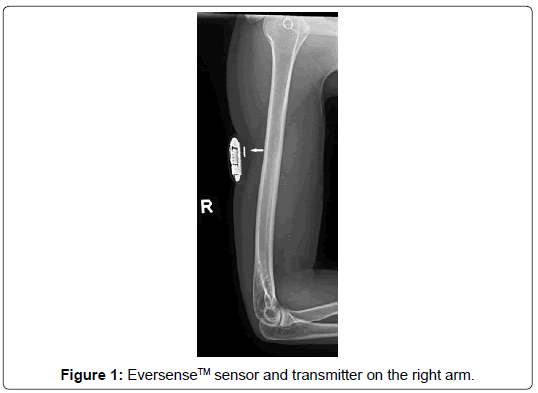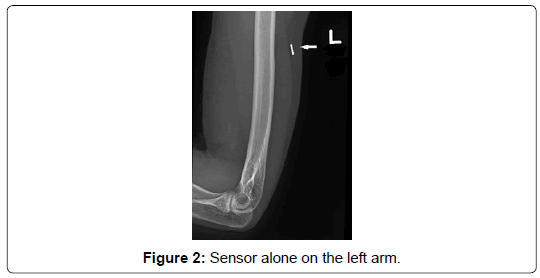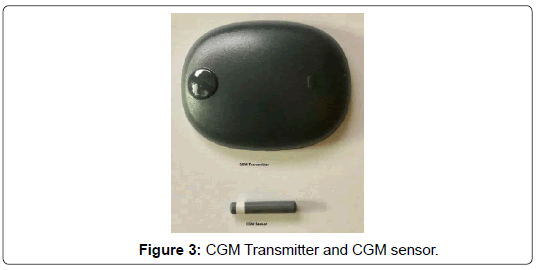Case Report, J Clin Image Case Rep Vol: 3 Issue: 1
Eversense TM Sensor and Transmitter - Interesting Radiological Images Seen on Plain X-rays of Upper Arms
Thanh D. Hoang*, Terry Shin and Mohamed K.M. Shakir
Division of Endocrinology, Department of Medicine, Walter Reed National Military Medical Center, Bethesda, Maryland, USA
*Corresponding Author: Dr. Thanh D. Hoang
Division of Endocrinology, Walter Reed National Military Medical Center, 8901 Wisconsin Ave, Bethesda, MD 20889, USA
Tel: +11 3012955165
E-mail: thanh.d.hoang.mil@mail.mil; tdhdthanh@gmail.com
Received: September 11, 2019 Accepted: September 25, 2019 Published: October 02, 2019
Citation: Hoang TD, Shin T, Shakir MK (2019) Eversense Sensor and Transmitter - Interesting Radiological Images Seen on Plain X-rays of Upper Arms. J Clin Image Case Rep 3:1.
Abstract
A 43-year-old woman presents to discuss continuous glucose monitor (CGM) technologies. She has type 1 diabetes mellitus diagnosed at age 14 and has been on insulin pump since 2001 which was upgraded to MedtronicTM 630G in July 2017. She has adequate glycemic control (A1c 7.3%), but finger-stick blood glucose levels fluctuate widely with occasional hypoglycemia. Past surgical history was noncontributory. She exercises regularly, walking 30 minutes several times per day with a goal of 7000 steps per day. She tried to use a CGM in 2018 (Medtronic) but she discontinued the CGM due to frequent alarms. Patient reports the alarms were not due to highs or lows, but due to difficulty with obtaining accurate readings. Patient consulted an endocrine clinic to improve blood glucose monitor with new CGM technology. EversenseTM CGM was placed on the left arm. Patient returned 3 months later for placement of a new EversenseTM CGM on the right arm and removal of the EversenseTM in the left arm. X-ray imagings of both arms showed the EversenseTM sensor and transmitter on the right arm and the sensor alone on the left arm
Description
A 43-year-old woman presents to discuss continuous glucose monitor (CGM) technologies. She has type 1 diabetes mellitus diagnosed at age 14 and has been on insulin pump since 2001 which was upgraded to MedtronicTM 630G in July 2017. She has adequate glycemic control (A1c 7.3%), but finger-stick blood glucose levels fluctuate widely with occasional hypoglycemia. Past surgical history was noncontributory. She exercises regularly, walking 30 minutes several times per day with a goal of 7000 steps per day. She tried to use a CGM in 2018 (Medtronic) but she discontinued the CGM due to frequent alarms. Patient reports the alarms were not due to highs or lows, but due to difficulty with obtaining accurate readings. Patient consulted an endocrine clinic to improve blood glucose monitor with new CGM technology. Eversense™ CGM was placed on the left arm. Patient returned 3 months later for placement of a new Eversense™ CGM on the right arm and removal of the Eversense™ in the left arm. X-ray imagings of both arms showed the Eversense™ sensor and transmitter on the right arm and the sensor alone on the left arm (Figures 1 and 2).
CGM devices measure the glucose level of interstitial fluid which correlates well with plasma glucose. Glucose levels are measured every 5-15 minutes, depending on the device. The Eversense™ sensor (Figures 1and 2) is placed in the upper arm by a physician. Once inserted, it continuously measures glucose levels for up to 3 months. The Eversense™ smart transmitter sits over the sensor on the upper arm. The transmitter is water-resistant, rechargeable, and can be easily removed. Not only can the transmitter can send data to the Eversense™ mobile app but it can also provide on-body vibration alerts when glucose level fluctuates high or low. The Eversense™ Mobile App receives and displays the data easy-to-read charts and graphs, making it easy for patients to monitor their blood glucose levels. The difference between Eversense™ CGM system compared to other CGM devices are that (a) there is no weekly sensor self-insertion since Eversense™ CGM lasts up to 3 months, (b) sensor is placed under the skin; thus, no concern about it falling off, (c) no separate receiver is required; data, trends and alerts can be viewed on mobile device; (d) highs and lows can be detected quickly. Many CGM devices allow patients to share their blood glucose data in real time with friends, relatives, and caregivers using a smartphone app, which may be particularly important when patients have hypoglycemia. The case demonstrates an interesting radiological finding of an implantable CGM sensor (Figure 3), and also the importance of awareness of various CGM systems with different safety advantages to improve diabetic care.
Acknowledgment
The views expressed in this article are those of the authors and do not reflect the official policy or position of the Department of the Army, Department of the Navy, Department of Defense, or the U.S. Government.
Disclosure
The authors have no multiplicity of interest to disclose.
 Spanish
Spanish  Chinese
Chinese  Russian
Russian  German
German  French
French  Japanese
Japanese  Portuguese
Portuguese  Hindi
Hindi 


